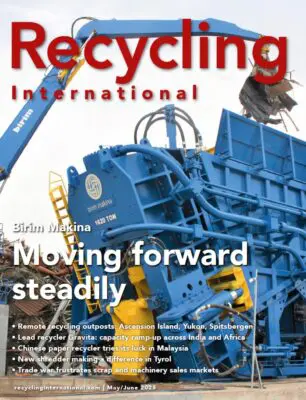30
BUSINESS
annually – all of which must be sorted,
baled, stored and eventually trans-
ported off the continent by ship or
cargo aircraft.
LOCALS AND CRUISE TOURISTS
Spitsbergen, some 1 300 km from the
North Pole, is one of the northern-
most inhabited regions of the planet.
With its Arctic climate, icy fjords and
spectacular northern lights, the island
presents unique challenges for waste
management, including freezing tem-
peratures as low as -20°C.
The archipelago’s largest settlement
is Longyearbyen. It has its own munic-
ipal waste management company
serving 2 500 inhabitants. The waste
recycling facility has been in place
since permanent settlement began in
the 20th Century.
After moving into a new building in
2022, the company handles some 2
000 tonnes of household and com-
mercial waste per year. Waste vol-
umes go up in summer due to the
arrival of up to 5 000 cruise tourists.
To manage the inflow of waste, staff
numbers temporarily double from two
to four.
The waste facility is divided into two
main areas. In the public front sec-
tion, residents drop off their waste,
which is then sorted. In the back, all
waste from the island is processed.
They have material handlers and even
a small shredder. After passing along
a short sorting line, the material is
baled, foiled and loaded into contain-
ers. The containers are then shipped
to the mainland, where the waste is
either recycled or incinerated.
CANADA’S ELV CHALLENGE
Another unique package of challeng-
es comes from recycling end-of-life
vehicles (ELVs) in remote areas of
Canada. In such isolated places, ELVs
are either dumped in landfills or at
transfer stations that often attract
wildlife, especially bears. This creates
serious safety risks, requiring extreme
caution, according to a report pub-
lished by Automotive Recyclers
Canada (ARC).
ARC also points to access issues,
including bad roads, ice roads, or ‘no
LACK OF SPACE ON HAWAII’S LANDFILL
Island Recycling, Hawaii’s leading scrap recycler, has modernised its non-
ferrous facility with a major upgrade from Wendt Corporation. The cen-
trepiece of the investment is a car shredder, equipped with a 2 500 horse-
power motor. The machine replaces an outdated 1 500 horsepower shred-
der, boosting performance and energy efficiency.
Founded in 1983 by Jim Nutter, Island Recycling began in a modest ship-
ping container. Today, under second-generation leader Nick Nutter, the
family business operates two facilities and processes 60 000 tonnes of
scrap per year – from households, businesses and government sources.
With landfill space being limited and expensive on Hawaii, improving mate-
rial recovery was crucial. ‘Our old shredder failed to deliver consistent per-
formance,’ says Nutter. ‘It struggled with throughput, had structural weak-
nesses and suffered repeated drive failures.’
Pronar’s Hubert Mackowiak: ‘French overseas territories like Reunion and Guadeloupe
offer growing business.’
28-29-30-32-33-34_remoterecyclingoutpost.indd 30 10-04-2025 12:19




